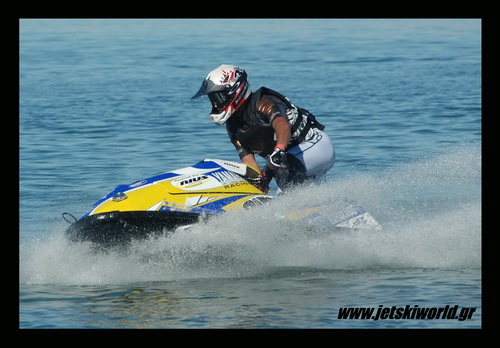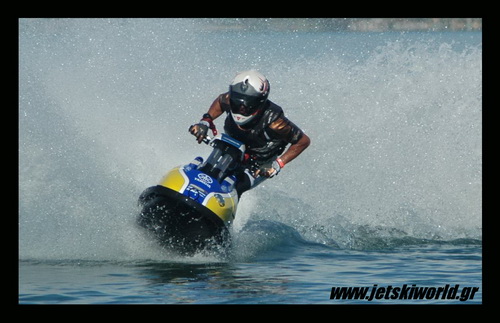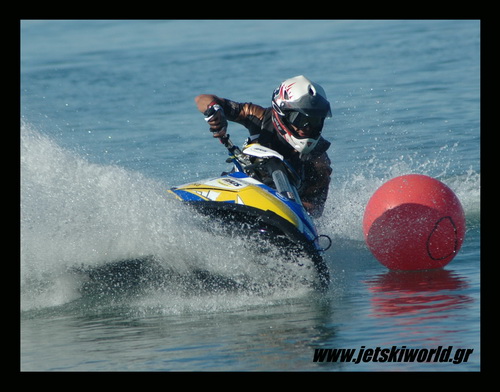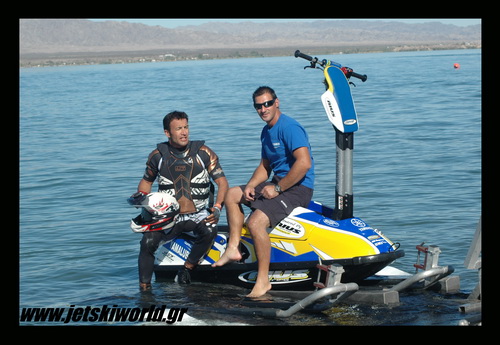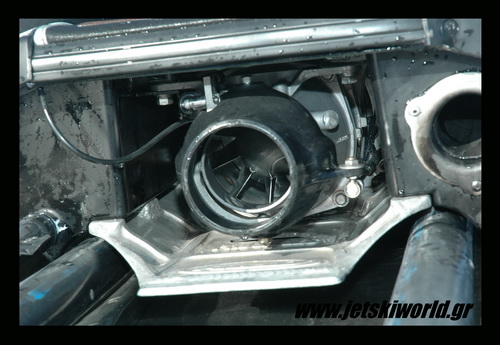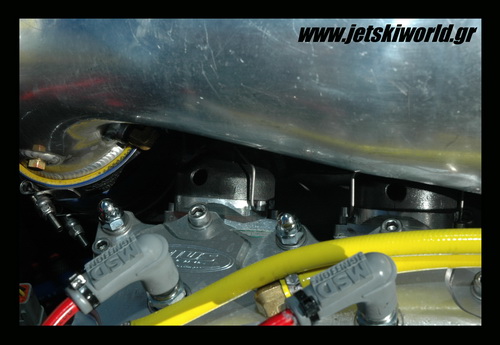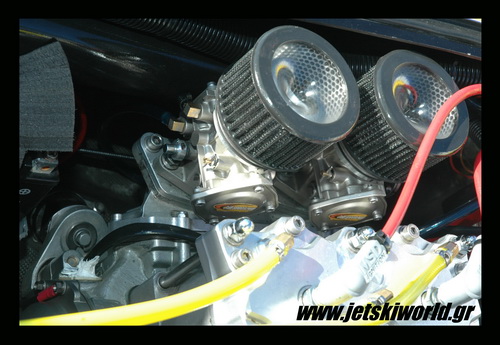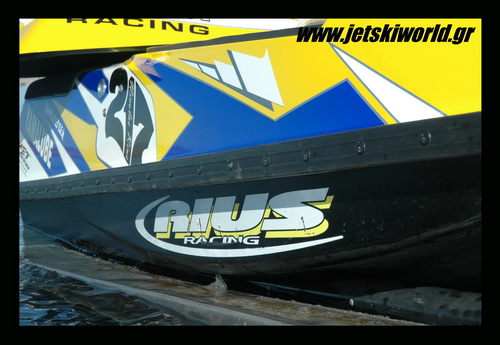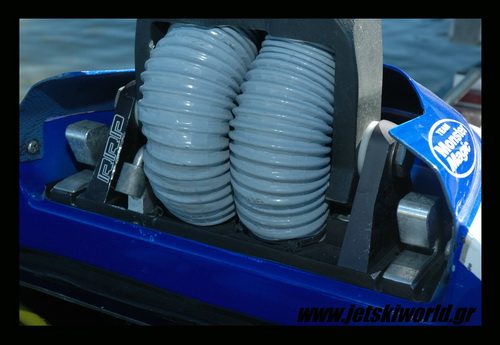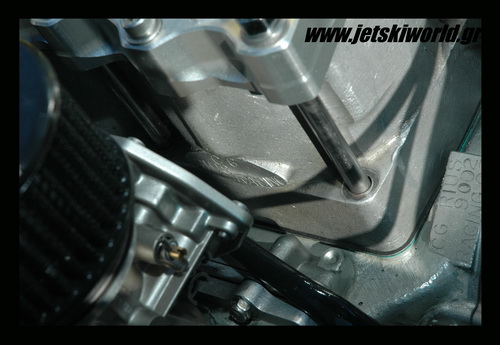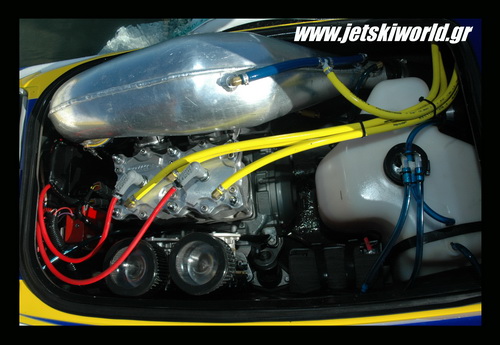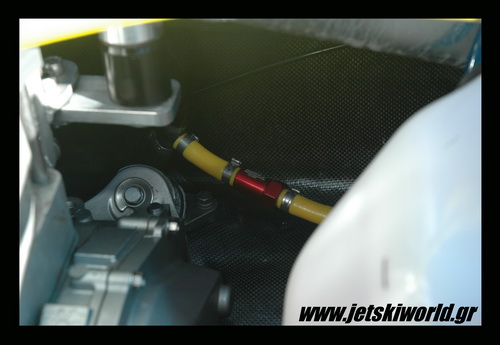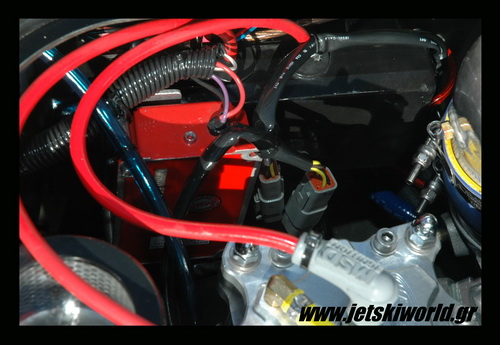In a class of its own
Rius racing has worked hard in order to design and manufacture a brand new carbon hull along with a special engine package in order to dominate in the GP Ski class of the European Tour. Undoubtedly, Rius Racing Super Jet is in a class of its own.
Words: Vasilis Moraitis
Photos: www.jetskiworld.gr
During the 2006 season there was a lot of talking between the EJSBA representative Yves Van Heers and the IJSBA in regards to the clicking from Superstock to Modified (again) only for the Pro Classes. The EJSBA run the European Tour according to a new set of Rules that benefited the teams who had the cash to design and fabricate special carbon hulls. One of these teams was Rius Racing who showed up in the first round of the European Tour with a special Super Jet equipped with a ballistic, super fast motor. Rius dominated the GP Ski class during all season though the rules have not been changed by the IJSBA, therefore he joined the spectators having no Runabout prepared to match the speed and acceleration of the powerful four strokes. Since we have long time cooperation with Rius Racing we visited the premises of the Team in order to find out what is hidden behind this special project.
According to EJSBA rules it is allowed to use a one off hull as well as to fit any type of engine since it meets the safety permits. Therefore, Rius Racing Team began their design during the winter. Chief mechanic Christophe Girello designed some special parts that where fit on the standard Super Jet hull. After extensive testing and modifying Rius and Girello reached a final conclusion, about the shape of the hull. Then they came into contact with a specific carbon parts maker, a person they could absolutely trust since this was an under cover project. The team flew from Lake Havasu city Arizona to France in order to hand make four hulls for the 2006 season. The final result was absolutely magnificent according to Girello.
The new carbon hull is a bit longer than the standard one and it incorporates built in front sponsons a design that originally was used on the Kawasaki SX-R and then adopted by Hydrospace too. Though, Girello assured me that the new hull is not a carbon copy of the Kawasaki, as many people believe. The front part is almost the same as the Yamaha OEM hull whilst the rear part has deeper chines in order to enhance traction, straight line stability and high speed cornering. The built in sponsons increase the frontal surface area and provide better handling when you approach the buoy. The hull manufacturer gave great attention to detail since carbon fiber is a very nasty material. The angle, the layers as well as the quantity of the resin play key role to the overall strength, weight and torsional rigidity. The immaculate design and great finish are exposed to the experienced eye, especially when some body takes a closer look at the engine compartment.
The engine compartment accommodates the new motor that is based on the Blaster II engine. Super Jet fanatics were praying for years for Yamaha to make this switch but it has never happened. Girello decided to use this engine spec in order to benefit from the torque and powerband characteristics. This was actually the point were he decided to work on and he succeeded since the heavily modified engine had massive torque release that translated to arm pumping acceleration. Rius managed to top the list on chrono testing during the European Tour according to Girello. The engine displacement was increased by using Kawasaki pistons. The cranking compression was brought to the desired limit by using the Rius Racing billet aluminum cylinder head that has removable domes. The YPVS system was ditched and pneumatics valves were installed in order to match the rest of the engine’s tuning characteristics. Spark was provided to the plugs by the MSD total loss ignition system. Fuel was fed through a specially made for Rius set of carbs of Full Spectrum. The engine exhales through a R&D dry chamber, a custom made chamber by Chapin of R&D that incorporates larger volume and different angles to match the new engines characteristics. Last year the exhaust was supplied with a Micro Touch water injection system which Girello installed in order to alter the power band according to Rius standards.
Horsepower is translated into thrust via a Skat-Trak magnum pump that utilizes a drop nozzle system made by Yamaha OEM parts. Intake grate and ride plate were both supplied by R&D. The plate was designed by famous tuner Bill Chapin and it incorporates multiple holes at the sides as well as under the pump section in order to enhance straight line stability and high speed cornering. The trim system is actuated by a hydraulic system. Girello fitted an RRP handlepole as well as pole bracket in order to increase the air intake to the engine compartment. The rest of the steering system comes from UMI Racing.
The lightweight feeling of the hull was the first noticeable fact that surprised me when I stepped on Rius’s Super Jet. That was a feeling I had not felt since 1999 when I had ridden a carbon hull SXi Pro. The highly tuned engine was a real screamer. It was powerful with crispy arm pump acceleration. The power was spreading out strongly from very low rpm and was getting stronger as the revs were building up. Seriously I do not know what the rpm limit was, though, up to this point this Super Jet kept getting stronger without stopping. The deceleration was heart breaking too. As soon as I went easy on the throttle the carbon hull got stack on the glassy Havasu water surface making me stick my foot on the tray in order to remain on board. At the beginning I had to brake, i.e. decelerate earlier when I was approaching the buoy and get earlier on the gas again. You need to practice a lot in order to find out the ideal braking distance.
Though the fact that surprised me most of all was how it was steering round the buoy. This Super Jet was turning like if it was on rails. No matter how much I was leaning Rius’s Yamaha hooked up superbly like no other Super Jet and it turned much tighter than I was expecting it to do so. The harder I was pushing it round the buoy the sharper it was turning. It was a unique feeling that no other Super Jet or other stand up had given me. Undoubtedly the team had done a great job. The steering was precise and very accurate. The lightweight feel and the good weight distribution provided me with the exact information of how the hull was gripping therefore no matter how much I was pushing its limits, it responded well by providing exceptional handling with absolutely no signs of subbing the front end or losing grip from the rear. By using the manual hydraulic trim I was always keeping the nose down while accelerating from one buoy to the other.
There were only a few teams and privateers that had shown up with an actual GP Ski in Europe. One of the very first ones was Rius Racing with this unique hull that a year later Yamaha decided it to bring it into production and reborn the new Super Jet. It was such a shame that Nicolas Rius was injured at the European Tour and was not able to participate in the GP Ski at the World Finals. Hopefully, the GP Class will show up stronger next year. It would be interesting to see a breath taking race on hand made super fast Ski’s.
Nicolas Rius #217: Yamaha Carbon Hull Super Jet
Engine
Yamaha OEM crankshaft Stroker
Yamaha OEM crankcases Ported by C.Girello
GP 800 cylinder with pneumatic power valves ported by C.Girello
Rius Racing pistons and rings
Rius Racing cylinder head for flat top pistons
Compression: Less than 200psi
R&D Special made exhaust system (volume angle)
Boyesen intake manifold
Boyesen reed valves spacers
Full Spectrum 50mm carburetors Special for Nicolas Rius
Stock fuel pick up modified
Prok flame arrestors (short)
Cooling lines in: 2 in manifold or a 3rd according to the needs
Cooling lines out: 2 or 3 according to the needs
Electrical
MSD Total Loss ignition
MSD flywheel
NGK Spark Plugs
Pump and driveline
Skat-Trak Custom made diameter, 12 vain Magnum One-off Pumpw/10mm Setback
Skat-Trak originally three blade, stainless-steel Swirl Impeller pitch by C. Girello
Drop nozzle system made by Yamaha OEM parts
UMI Racing Couplers
Reduction nozzle: Not mentioned
Steering nozzle: Not mentioned
Hull and Handling components
R&D carbon hood
R&D carbon nose piece
Rius Racing pad covers with lifters
Rius Racing mat
UMI Racing billet aluminium by-pass fittings
Custom Rius Racing ride plate
Custom Rius Racing intake grate
Steering assembly
RRP handlepole
Yamaha handlepole pad
Rius Racing pad cover
UMI Racing 0 degrees handlebar
UMI Racing turn plate
Grips not mentioned
UMI Racing trigger throttle lever
Hydraulic trim lever
Top speed: Not Mentioned
Team Sponsors
Yamaha France, Yamaha Europe, Yamalube, OCD paint job, Shark, Oakley, Quakysence, Monster Magic Team, Jet Import France, RRP
